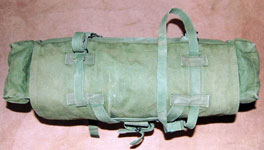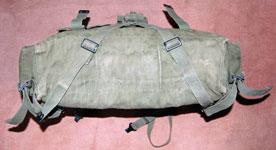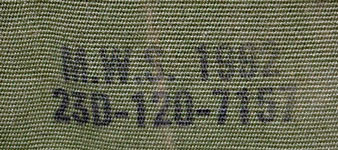| Karkee Web Home Page | Pattern 1958 Home Page | Patt. '58 Components Page |
Web Equipment, Pattern 1958 - Components
Pack
Stores Ref. CN 0034 PACK, MK. 1
Stores Ref. CN 8465-99-973-6220 FIELD PACK, Canvas, with spigot carrier for shovel
Stores Ref. CN 8465-99-973-6220 FIELD PACK, Cotton webbing,


 Thus far, all items described above, were relatively well-designed, albeit with some short-sightedness. With the Pack, the Army seem to have taken leave of their senses. The basic envelope – of much widened Patt. ’44 form, was not a problem, giving a far greater carrying capacity than even 2nd Issue Patt. ’44 Haversacks. It was complete with side pockets, though these were of exceedingly small cross-section, when compared to Patt. ’44, whose side pockets would hold half of a rectangular Mess tin. The problem was its attachment to the wearer’s equipment. The upper edge was slightly stiffened by a double thickness of web material, into which were set a pair of semi-circular metal loops, fitted with straps in 1-inch webbing. These had an integrated adjustment
buckle and had their ends furnished with a Mills patent hook, an older brass component, but here made in anodised aluminium. These straps were passed over the padded portions of the Yoke (O.K. so far), where they were then hooked onto the semi-circular loops above the QR adjustment buckles on the front ends of the yoke flares. Its weight was therefore hung on these, in the manner of the U.S. M-1936 “Musette” Bag, with whatever support the filled Rear pouch could give. From the Simon Howlett Collection. Photos © Simon Howlett 2012.
Thus far, all items described above, were relatively well-designed, albeit with some short-sightedness. With the Pack, the Army seem to have taken leave of their senses. The basic envelope – of much widened Patt. ’44 form, was not a problem, giving a far greater carrying capacity than even 2nd Issue Patt. ’44 Haversacks. It was complete with side pockets, though these were of exceedingly small cross-section, when compared to Patt. ’44, whose side pockets would hold half of a rectangular Mess tin. The problem was its attachment to the wearer’s equipment. The upper edge was slightly stiffened by a double thickness of web material, into which were set a pair of semi-circular metal loops, fitted with straps in 1-inch webbing. These had an integrated adjustment
buckle and had their ends furnished with a Mills patent hook, an older brass component, but here made in anodised aluminium. These straps were passed over the padded portions of the Yoke (O.K. so far), where they were then hooked onto the semi-circular loops above the QR adjustment buckles on the front ends of the yoke flares. Its weight was therefore hung on these, in the manner of the U.S. M-1936 “Musette” Bag, with whatever support the filled Rear pouch could give. From the Simon Howlett Collection. Photos © Simon Howlett 2012.
Thus was discarded half a century of Mills design, in supporting a dorsal load with counter straps under the arm. Nor was it so that the under-arm area was free of constricting straps, either! Borrowing directly from U.S. M-1956, an adjustable strap was stitched to the pack sides, located below the side pockets and angled downwards. The doubled strap held a levered spring hook – another old Mills component – which was to be connected to the outer sides of the yoke loops on the Ammunition pouches. U.S. M-1956 used exactly this method, albeit on a Carrier for a much lighter load, namely the Sleeping bag. Neither country’s design afforded any ergonomic support to the dorsal load, the lateral straps serving only to prevent “pack bounce”, or tendency towards swaying.
Whilst Major Burrowes must have been turning in his grave, it should remembered that Patt. ’58 was only made by Mills (and others) – it was not designed by them. Fortunately, the Pack was rarely worn, being left in unit transport, though it was part of CEMO – Complete Equipment Marching Order. Just to complete the insult, the “flat” portion of the main pack flap was fitted with two integrated straps, which served to secure “…the great coat…” originally, but later the standard Army Sleeping Bag. As this came later, the bright spark designers had the bag roll into an integrated waterproof “half-bag”, where it was held by loops and plastic toggles. Just one problem – the length of the rolled Sleeping bag was less than the distance between the “blanket” straps!!! As the Americans might say, “Go figure!”
To further add insult, there were crossed straps over the flap, in the manner of Patt. ’08 / ’37 Straps, pack supporting, only these did no such thing, being present solely to hold the Mark 4 Steel helmet. An identical “Spigot carrier” was stitched near the lower edge of the flap. Above it, there was what appears as a “grab handle”, but which was actually a stowage for the assembled Lightweight pick. The closure straps on the box-lidded side pockets and the main flap, but also the crossed helmet straps, all had U.S. style crimped tips.
Stores Ref. CN 8465-99-120-7157 FIELD PACK, Modified [Issue 2]
Stores Ref. CN 8465-99-120-7157 FIELD, PACK, 17 in. lg, 5 in. w, 14 in. h [Issue 2]
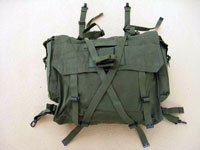
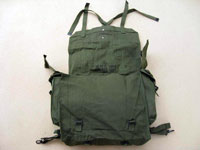
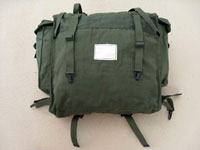 The stiffened sides to the box-lids of the side pockets were deleted and all crimped tips on strap ends were changed to eyeletted versions. What the Army give as “long” is actually its width and is only the main body. From the outer seams of the pockets, across the whole, is approximately 19.5-inches. At the time, it was the widest Pack ever used in the 20th Century and greatly reminiscent of the box Knapsacks of early 19th Century Knapsack Equipment.(K.E.). The Patt. ’08 Pack was only 13-inches wide. Excluding the volume of the side pockets, the Patt. ’58 Pack was over 20% larger, with external provision to add a Sleeping bag as well – all supported by a system that was markedly inferior to that used for Patt. ’08!!
The stiffened sides to the box-lids of the side pockets were deleted and all crimped tips on strap ends were changed to eyeletted versions. What the Army give as “long” is actually its width and is only the main body. From the outer seams of the pockets, across the whole, is approximately 19.5-inches. At the time, it was the widest Pack ever used in the 20th Century and greatly reminiscent of the box Knapsacks of early 19th Century Knapsack Equipment.(K.E.). The Patt. ’08 Pack was only 13-inches wide. Excluding the volume of the side pockets, the Patt. ’58 Pack was over 20% larger, with external provision to add a Sleeping bag as well – all supported by a system that was markedly inferior to that used for Patt. ’08!!
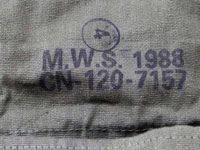 Note the marking -120-7157, which is the N.I.I.N. (NATO Identification Number) ) element of the longer N.S.N., prefixed with the C.O.S.A. Section CN prefix. From Terry Hawker Collection. Photographs © Terry Hawker, 2012.
Note the marking -120-7157, which is the N.I.I.N. (NATO Identification Number) ) element of the longer N.S.N., prefixed with the C.O.S.A. Section CN prefix. From Terry Hawker Collection. Photographs © Terry Hawker, 2012.
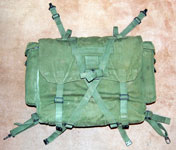
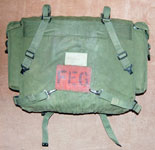

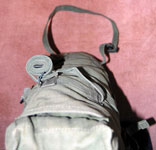 This second example also has its flap stencilled with the N.I.I.N. -120-7157, but here the prefix 23D. This shows it to be a code under the R.A.F. Air Publication A.P. 1086 Section 23D Accoutrements. From the Rog Dennis Collection. Photos © Rog Dennis 2012.
This second example also has its flap stencilled with the N.I.I.N. -120-7157, but here the prefix 23D. This shows it to be a code under the R.A.F. Air Publication A.P. 1086 Section 23D Accoutrements. From the Rog Dennis Collection. Photos © Rog Dennis 2012.
Rog Dennis 2012
